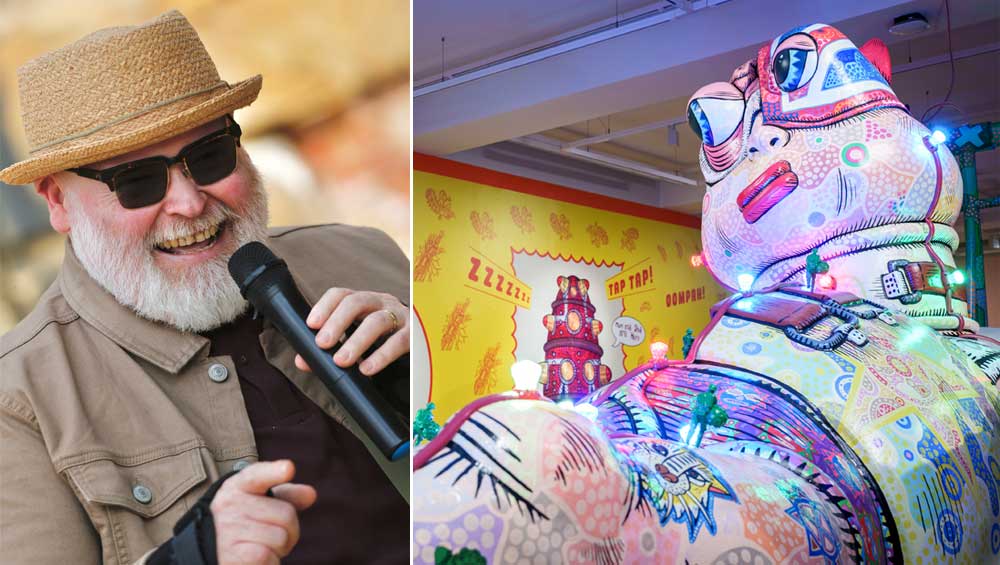
Portrait of Jason Wilsher-Mills. Courtesy of the artist. Right: Jason and the Adventure of 254 by Jason Wilsher-Mills at Wellcome Collection, London 2024. Photo: Benjamin Gilbert. Source: Commissioned by Wellcome Collection.
by ANGERIA RIGAMONTI di CUTÒ
Describing himself as “psychically locked” in the 1970s, Jason Wilsher-Mills (b 1969, Wakefield) has recreated a hospital ward of sorts in the Wellcome Collection, albeit one more reminiscent of Fellini and Niki de Saint Phalle than the NHS of early 1980s Yorkshire. To simply describe the exhibition as an investigation of disability, therefore, would be reductive in the extreme.
In a fantastical installation of monumental, Technicolor sculptures, illustrations and dreamlike, theatrical dioramas, Wilsher-Mills takes the viewer into his heightened, busy-busy imagination and fixation with his childhood, one that probably most of us share. Paralysed from the neck down from 11 to 16 after chickenpox damaged his central nervous system, and bedbound in hospital for a year, with the bleakest of prognoses, it is that confinement that is the centre of Jason and the Adventure of 254.
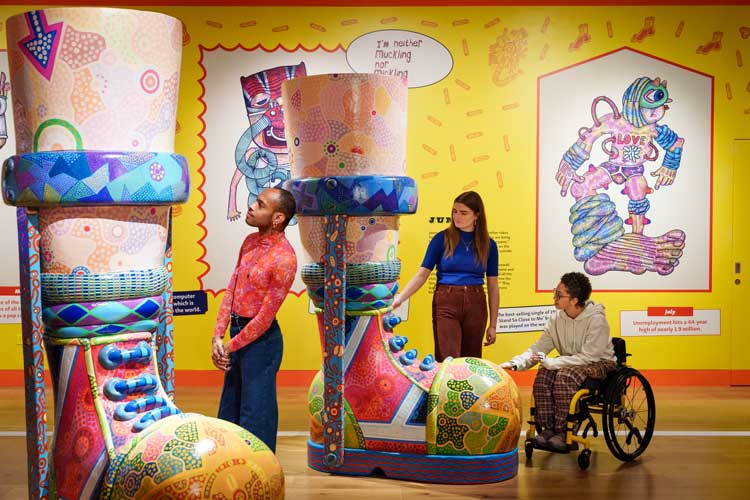
Jason and the Adventure of 254 by Jason Wilsher-Mills at Wellcome Collection, London 2024. Photo: Benjamin Gilbert. Source: Commissioned by Wellcome Collection.
For all the physical constrictions brought about by those events, the quasi-paradox of this story is that Wilsher-Mills’s physical paralysis and long hospitalisation somehow, almost miraculously, proved to be agents of a potent creative awakening that has drawn comprehensively on classics of English literature, cartoons, 1970s television and, in this case, the fascinating anatomical drawings of the Wellcome Collection. While the inestimable nourishment of loving family is palpable here, there is also a pleasing fury that pervades these works, even if dressed up in burlesque costume, one that is hardly surprising given the stark decline in some aspects of disability support over the last 40 years in the UK.
Wilsher-Mills is also currently showing at the Venice Biennale, in an exhibition of works by disabled artists, curated by Shape Arts. Studio International spoke to him on Zoom.
Angeria Rigamonti di Cutò: Your trajectory, medically and professionally, has taken some quite dramatic turns. To start with the first, after your year’s hospitalisation at only 11 years old, and the prognosis that you wouldn’t make it past 16, what happened next? Did the doctors change their minds? It must have been a terrifying calculation to live with.
Jason Wilsher-Mills: Basically – spoiler alert – I was paralysed from the neck down. I still have all kinds of problems with my hands, but this is amazing in comparison with how I was. But from the age of 11 to 16 I just lived with this sense of dread. I’m working on a sitcom about my childhood and it’s going to be a comedy. People are surprised by that, but I was so loved and cared for, and we never mentioned any of that stuff because it wasn’t the done thing. While I was worrying about my mortality, Mum and Dad were trying to cram as much as possible into my life in terms of experiences and we always talked about the future.
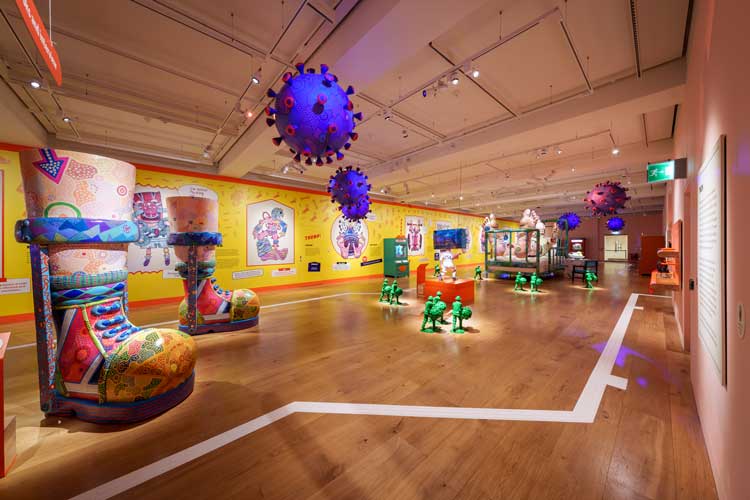
Jason and the Adventure of 254 by Jason Wilsher-Mills at Wellcome Collection, London 2024. Photo: Benjamin Gilbert. Source: Commissioned by Wellcome Collection.
When I got to 16, my spinal column had repaired itself to the extent that I could walk a bit again and got some feeling back. It was a bit of a miracle, that transition from being prepared to die to going to college and experiencing things I never thought I could. Even holding a glass was overwhelming because my senses were so fired up. Obviously, I was severely shell-shocked, but my mates and family gave me the leeway to be whatever I needed. At that age everything was lived in the present and I had a good life. But medically I’m a bit of an enigma; I was paraded on stage in my underwear in front of 300 consultants at a medical conference, as a 16-year-old just coming to terms with having a body.
ARC: You’ve said that the Pinderfields hospital school was instrumental in opening you to art, and one of your dioramas, Painting With My Mouth (2024), is testament to the education you received there. I was surprised by the extent of adaptations you were provided with to enable you to paint: a surgical collar, spinal brace, arm and leg callipers, as well as the device holding the paintbrush and pencil. In an era that you’ve described as generally not exactly progressive vis-a-vis disability, was this sort of provision typical?
JWM: They’d give you a pair of callipers and tell you how much they cost: this is £450 worth! When I became paralysed in 1980, they put a piece of medical paraphernalia on every part of my body, and I was effectively strapped into my chair. I even had a thing at home called a possum – you would blow into it, and it moved a light on a screen. I could open the curtains and door or communicate with my mum in another room.
-Jason-Wilsher-Mills.jpg)
Jason Wilsher-Mills. 254 Man, 2023. © Jason Wilsher-Mills.
ARC: Technologically, at least, it sounds advanced for the times.
JWM: It was. I’ve got hardly any support now; I’m going to have three operations but God knows when they’re going to happen because of where we are. In the 80s, I could stay in hospital for a year, I had a bungalow to move into, with hoists in it, visits from a district nurse and a chin-controlled wheelchair. Technology has supposedly moved on, but the support systems are not there any more.
ARC: You later went on to study art at Cardiff School of Art and Design. What was that experience like; was its impact as formative as that of the hospital school?
JWM: At the hospital, they taught me to paint but there was no formal education at the hospital school. One or two teachers noticed I was bright and suggested books for me to read. That’s when I got into Dickens and Thomas Hardy. At 13, I did an IQ test, and, surprise, surprise, I came out OK. So, I went from nothing to one-to-one education, studying for my O-level English literature and history, all the things I was interested in. But between 11 and 13 all I did was paint and occasionally watch TV.
When I got to Cardiff, I had done a foundation course at Wakefield, so I had had a taste of freedom. But I had quite dramatic post-traumatic stress that affected my behaviour. There were lots of distractions at college that were new to me, interesting and scary, for which I had no points of reference because I’d missed out on so much, puberty for instance. I think there’s a whole other exhibition about everything that came afterwards. But I dread to think what would have happened to me if I hadn’t had that particularly virulent strain of chickenpox. I might have been working in a factory – nothing wrong with that, but I’d have been dreaming about all this stuff.
-Jason-Wilsher-Mills.jpg)
Jason Wilsher-Mills. Bigfoot, 2023. © Jason Wilsher-Mills.
ARC: A less formal cultural force also seems important to your work: television. Your works contain many references to the medium and in one you’ve even replaced Sebastian Coe’s head with a boxy TV set. To what extent did your intensive consumption of television during your long hospitalisation inform you?
JWM: It was only when I read Grayson Perry saying that he watches a lot of TV that I felt vindicated. I didn’t have a choice; it was in front of me and on all the time. And it happened that just as something historic was happening, something personally historic was also happening to me. William Blake would love the way the stars aligned, with Seb Coe wearing 254 [at the 1980 Moscow Olympics, where he won the 1500m gold medal] when, within that 10-minute window, I was being diagnosed.
ARC: After these dramatic formative experiences, your life took another unexpected turn when you went on to work in education management for some years, before having a change of heart and committing yourself to being an artist. Was that a scary change at that stage and what prompted it?
JWM: Doing art is like cultural national service. I had this inverted snobbery that because I came from a working-class background, I couldn’t do it. In those days it was so laboured, you had to send so many slides. My timing wasn’t right, I describe it as not being fully baked. I had to go off and have some life experience, of a different kind. I was an art teacher in a prison for many years and then became a manager in an further education college, the worst decision I ever made. It coincided with a real decline in my health, I was on morphine and God knows what, and in so much physical pain. The decision to become an artist was really a pragmatic one; I would have lost my house because I could no longer work.
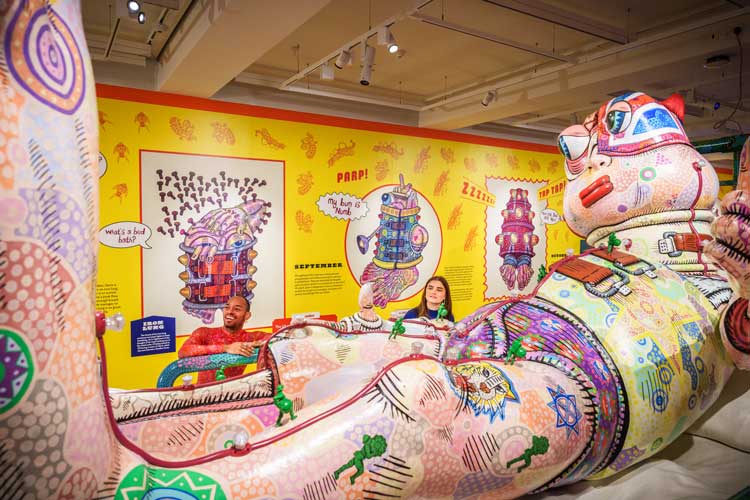
Jason and the Adventure of 254 by Jason Wilsher-Mills at Wellcome Collection, London 2024. Photo: Benjamin Gilbert. Source: Commissioned by Wellcome Collection.
ARC: The way you depict the body is potently expressive and you often do this through distorted scale, for example your feet often rendered as massive; your eyes, too, often huge, perhaps because your visual powers became so acute. In some works, you also reveal internal parts of the body. Do you think that disability gives you a much more highly attuned relationship with your body?
JWM: Yes, because I spent most of my life with pins and needles in my hands, in acute pain, so my body became a kind of battleground, with my own immune system, the “soldier” white blood cells, attacking me. I always felt something happening inside me at a molecular level. I remember watching Jonathan Miller’s documentary series about the way we perceive our bodies, The Body in Question (1978). There was a sculpture in it, with really big hands, because we have so many nerve endings there. And we perceive our faces generally to be proportionally bigger, because that’s where “we” are. It was a representation of the human body where everything is askew and mine was a bit of a nod to that.
ARC: There’s also a political bite to your work, bearing in mind that as a boy you were refused entry to the cinema because your wheelchair was deemed a fire hazard. In 2015, you made a work about the 1995 Disability Discrimination Act, while an image in this exhibition, Brave Boy Billy (2024), a reworking of an earlier version, is a chilling reminder of the 2016 statistic that, of the 60 million people worldwide who need a wheelchair, only 15 million have access to one.1 That work also shows a skull and crossbones with DWP [Department for Work and Pensions] emblazoned above them. Do these things make you angry?
JWM: Yes. I hide things in plain sight. The company that builds my inflatable sculptures asked me why I had the letters DNR on one of my works. I explained that one of my friends and his family had a terrible experience during Covid and were bullied into signing a Do Not Resuscitate order. Hopefully, one day a lot will come out. In one night in 21st-century London I passed 30 restaurants and couldn’t get into any of them. I ended up going to Nando’s every night, it was the only place that had a ramp. There is certainly a lot to be angry about.
And I’ve already been quoted as saying that if you have a disability and apply to the DWP for support, you immediately become an activist just by having to complete the form. Hopefully the next lot will improve things.
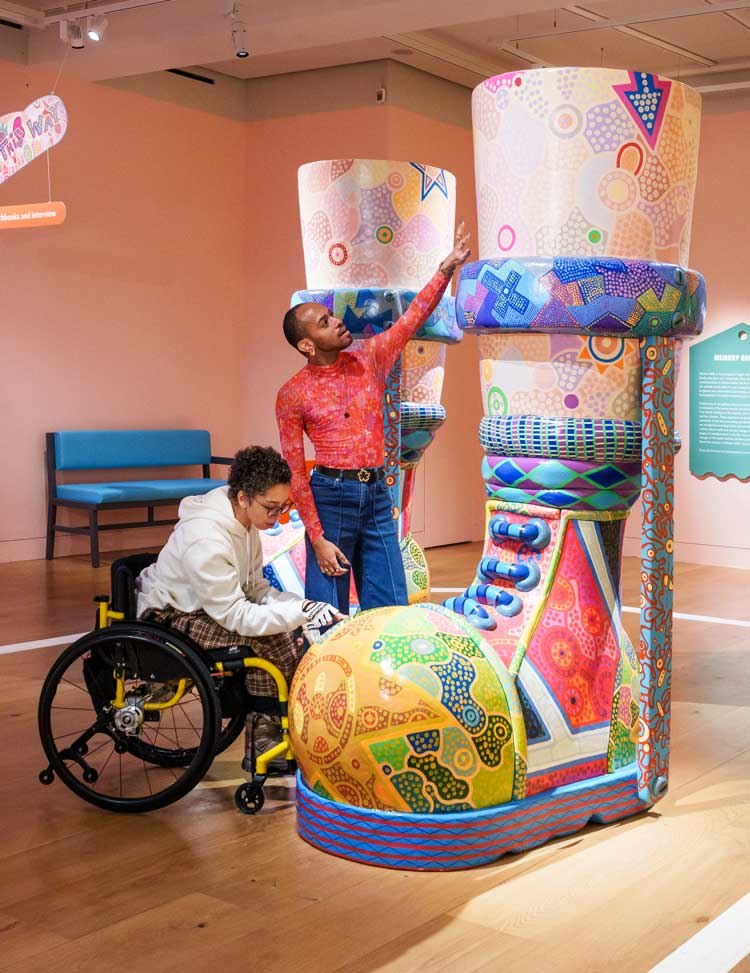
Jason and the Adventure of 254 by Jason Wilsher-Mills at Wellcome Collection, London 2024. Photo: Benjamin Gilbert. Source: Commissioned by Wellcome Collection.
ARC: At the same time, you unwaveringly transform elements of your disability with humour, for example in the work depicting a giant pair of callipers, which you’ve described as “instruments of torture”, or when referring to antiquated and constricting wheelchairs as “beautiful machineries of joy”. Is humour the best weapon?
JWM: Yes, and, conversely, if you shout at people they don’t listen. I figured that out pretty early. If something is humorous, people see that as an interesting doorway into the work. If it’s making them laugh, I’ve got them, even if I’m talking about trauma.
ARC: Many of the dreamlike elements you incorporate into the works are captivatingly bizarre: the disabled cod, your mother swimming with colonies of giant fluorescent jellyfish, the omnipresent viruses and huge ferret. One I found especially fascinating is Hippo Scare (2024), a portrayal of your first encounter with a hippopotamus. But the most bizarre element is the opposing, winged figure with a hippo’s head, a being you’ve described as a depiction of your illness that transcends into a creative force. Do you think that the unknown is frightening but that if you confront it, it can give you flight?
JWM: The hippo was a really vivid memory, in this dark gothic zoo, with a tank of brown water and a huge thing moving around in it; it was straight out of a horror story. It was similar to that overwhelming feeling I get if I touch something. Looking back, I realised that seeing something that visually overexcited me was too much, whereas now I would have drawn it – that’s how artists make sense of the world, by drawing or painting. It’s taken me nearly 50 years to work out that this experience of seeing a huge jaw opening was happening to tell me that I was an artist. The great thing about the Wellcome Collection was that they knew the show might be triggering for me, so they provided me with counselling.
ARC: A lot of your work, especially the dioramas, would lend itself well to a cinematic or animated form: do you have any plans in that direction?
JWM: It’s in the works. The sitcom won’t be straightforward. They’ll be interruptions, because that’s how I see the world, the surrealism which is hidden in plain sight in our lives, which is one of the reasons I find William Blake so exciting because he was able to articulate it. Even as a kid, when I didn’t have the ability to articulate it, I knew I was seeing things in an interesting way.
Reference
1. These figures have since increased: World Health Organization (2023) Wheelchair Provision Guidelines.
• Jason and the Adventure of 254 is at the Wellcome Collection, London, until 12 January 2025.